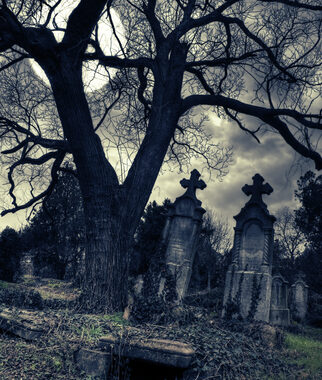From Mary Shelley to Horace Walpole, why Gothic novels have stood the test of time
Crisp fall weather calls for chill-inducing reads, and there’s nothing better for that than a good gothic novel. In more than 250 years, the gothic has never been out of style, though it’s undergone transformations and has had more than one name.
We date the beginning of the gothic in literature to Horace Walpole’s The Castle of Otranto in 1764. Walpole coined the term, though he was being facetious and used the term to describe the medieval aspects of his story. But with his novel, Walpole gave us all the themes we’ve come to know—and love—in gothics:
- An ancient/abandoned/creepy house or castle in an isolated location
- A protagonist living without a safety net
- Questions of reality, madness, life on the edge of death and where the line between them falls
- A supernatural—or apparently supernatural—threat
- Doubling (twins, mirrors)
- Incest/swapped children/illegitimacy
- Orphans, dead families, the end of a family line
- A pervasive mood of gloom and dread
Where Walpole’s novel was a tragedy, it was quickly followed by a whole slew of gothic romances, most of which were written by women, with female protagonists, all of whom found love at the end. The earliest well-known example of this is Anne Radcliffe’s The Mysteries of Udolpho, first published in 1794. There’s a ridiculous amount of fainting, random acts of poetry, and overblown language in Udolpho, but it also exhibits all the important characteristics that identify a gothic.
In 1818, Mary Shelley took the gothic in a new direction with Frankenstein, or the Modern Prometheus. Where earlier gothics had included hints at the supernatural, groaning and moaning, curses and ghosts, Mary Shelley described the invention of the monster, the birth of the fear that pervades the entire genre. She delves deeply into the line between madness and reality, life and death, which leaves its stamp on the whole genre.
In the 1960s and 1970s, a new group of women took up the reins. Dozens—perhaps hundred—of women wrote pulp gothics that came out from every major publisher in America to the tune of four to six new titles a month. They all had similar covers—women with fabulous hair fleeing from creepy old houses while wearing improbable floaty nightgowns.
While huge numbers of women were writing this new wave of gothic romance, there were three undisputed queens: Mary Stewart, Victoria Holt, and Phyllis A. Whitney. My favorite of the three is Mary Stewart, and if you’re going to read just one of her books, I’d urge you to read Nine Coaches Waiting. Or possibly This Rough Magic. Or… well, you get the idea.
While none of these gothic romances were truly paranormal, during the same era Barbara Michaels (aka Barbara Mertz, aka Elizabeth Peters), wrote wonderful ghost-filled gothic novels like Ammie Come Home and Be Buried in the Rain.
The gothic is still going strong. If you love the genre, check out Silence for the Dead, Simone St. James’ novel set in a remote hospital for shell-shocked veterans after WWI. The tone, the subject matter, and the tropes all contribute to the claustrophobic sense of gloom St. James creates.
And then there’s Kristin Waldherr’s The Lost History of Dreams, with its post-mortem photographer protagonist. What could be more gothic? What post-mortem photographer wouldn’t see ghosts, after all? And the setting—19th Century moors with an abandoned, stained-glass chapel and a near-abandoned home, is the perfect spot for such a tale.
But gothics don’t have to be historical. Carol Goodman’s novels are usually called “domestic suspense,” but in her case that’s just another way of saying “gothic.” The Ghost Orchid, set in present-day upstate New York, ticks all the boxes that Walpole set out more than two centuries ago, and it does so in an utterly modern way.
So grab a book, sit down by the fire, and let the chills come from inside this season.
Laura K. Curtis gave up a life writing dry academic papers for writing decidedly less dry genre fiction. A member of RNA, MWA, ITW, and HWA, she has trouble settling into one lane. While she is best known as a writer of romantic suspense, she has also written contemporary romance novels and short crime fiction. A Darker Shade is her seventh novel, her first gothic and her first suitable for YA as well as adult audiences. Laura lives in Westchester, NY with her husband and a pack of wild Irish Terriers.

